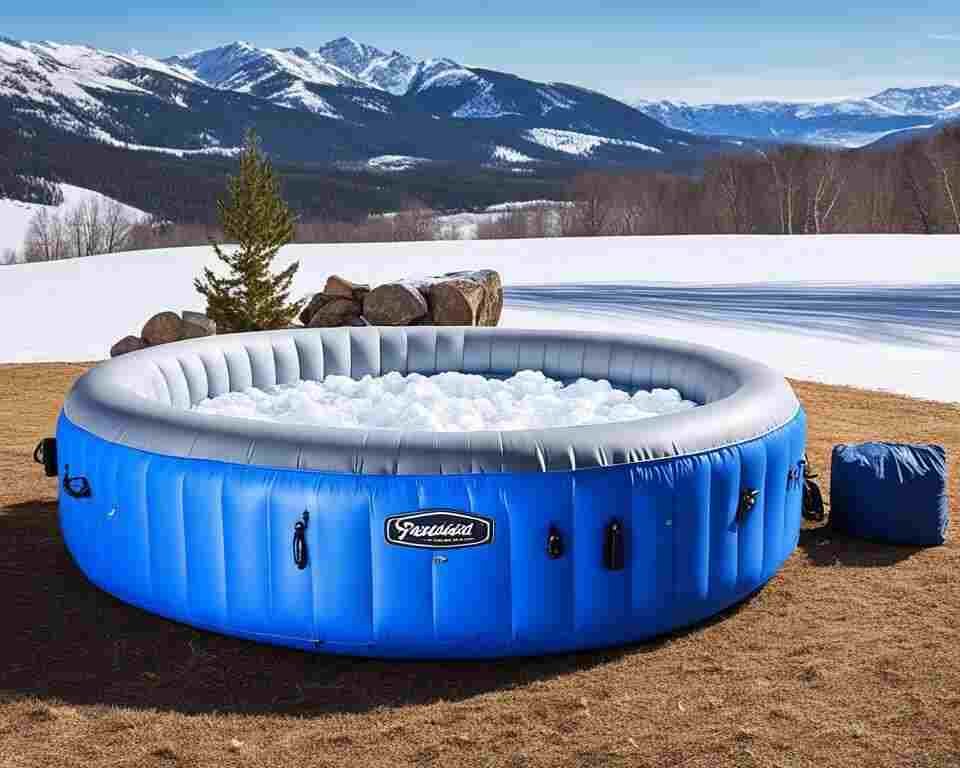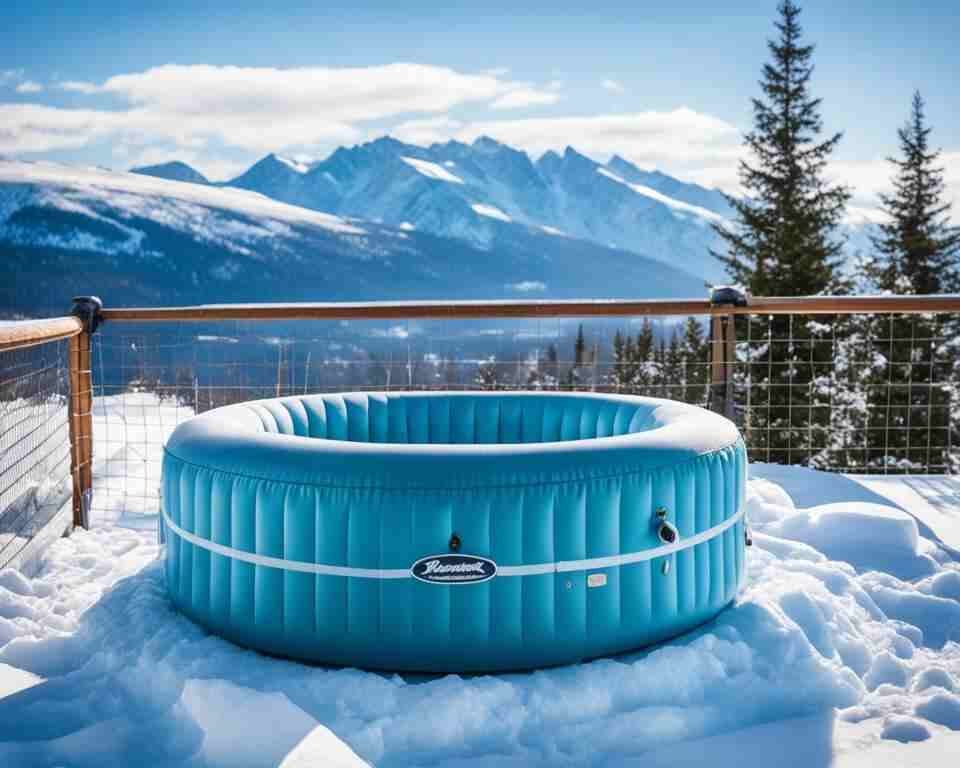Have you ever found yourself wondering, “Do inflatable hot tubs deflate in cold weather?” In this article, we’ll explore the effects of chilly temperatures on these tubs and discuss essential winter maintenance to prevent deflation.
Additionally, we’ll look into the challenges of retaining heat during colder months and explore available options to safeguard inflatable hot tubs in frosty climates. Join us as we uncover the secrets of whether your inflatable hot tub can withstand the cold!
Key Takeaways:
- Inflatable hot tubs can deflate in cold weather if not properly maintained.
- Air density and temperature play a significant role in the inflation and stability of inflatable tubs.
- Insulation solutions and winter maintenance can help protect inflatable hot tubs during colder temperatures.
- Keeping the heat in cold weather can be challenging and costly.
- Despite advancements in inflatable hot tub technology for winter use, most aren’t recommended for temperatures below 40°F (4°C).

Understanding Inflatable Hot Tubs and Cold Weather Dynamics
In this section, we will look deeper into the dynamics between inflatable hot tubs and cold weather. Understanding how cold weather affects inflatable tubs is crucial for their maintenance and longevity. By examining the factors that can influence deflation in chillier climates and the role of air density and temperature effects on inflatable tubs, we can better prepare and take necessary precautions to prevent deflation.
Factors That Influence Deflation in Chillier Climates
Several factors play a significant role in determining whether inflatable hot tubs will deflate in cold weather. The quality of the materials used, the inflation pressure, and the structural integrity of the tub can all impact its ability to withstand low temperatures. High-quality materials, proper inflation pressure, and a robust construction ensure that the tub remains resilient in colder climates. Regular inspections and maintenance can help identify any issues or potential areas of weakness.
The Role of Air Density and Temperature Effects on Inflatable Tubs
Air density and temperature effects are crucial considerations when it comes to inflatable hot tubs in cold weather. Cold air is denser than warm air, which means it can have an impact on the inflation and stability of the tub. As the air temperature drops, the air molecules contract, potentially causing a decrease in the air pressure inside the tub. This decrease in pressure can result in deflation or reduced firmness of the tub.
Additionally, extreme cold temperatures can make the inflatable material more brittle and susceptible to damage. It’s essential to ensure that the tub is properly insulated and protected from the elements to mitigate the effects of low temperatures on its performance.
| Factors That Influence Deflation | Role of Air Density and Temperature Effects |
|---|---|
| Quality of materials | Density of cold air |
| Inflation pressure | Air molecules contracting |
| Structural integrity of the tub | Decrease in air pressure |
Understanding these dynamics is essential for avoiding deflation and ensuring the longevity of inflatable hot tubs in cold weather. By taking cold weather precautions and implementing proper maintenance practices, hot tub owners can enjoy their relaxation oasis even during the winter months.
Challenges with Maintaining Inflatable Hot Tubs During Winter
Inflatable hot tubs provide a relaxing and convenient way to enjoy a spa-like experience in the comfort of your own backyard. However, when the colder months arrive, there can be some challenges in maintaining these tubs. The frigid temperatures and harsh weather conditions can have a negative impact on the performance and longevity of inflatable hot tubs. In this section, we will explore the specific challenges that hot tub owners face during winter and provide tips on how to overcome them.
Insulation Solutions and Winter Maintenance for Inflatable Hot Tubs
One of the main challenges with inflatable hot tubs during winter is ensuring proper insulation. Cold weather can cause the air inside the tub to cool down rapidly, resulting in heat loss and increased energy consumption. To address this issue, there are several insulation solutions and winter maintenance tips to consider:
- Use a thermal blanket or insulating cover: These accessories can help retain heat and prevent energy wastage by reducing heat loss through the surface of the tub.
- Check and maintain air temperature: Regularly monitor the air temperature inside the tub to ensure it remains at an optimal level. Adjust the heater accordingly to compensate for any heat loss caused by the cold weather.
- Protect the tub from harsh elements: Shield your inflatable hot tub from rain, snow, and strong winds by setting up a gazebo or other protective coverings. This will help maintain a consistent temperature and protect the tub from potential damage caused by exposure to the elements.
By implementing these insulation solutions and winter maintenance practices, you can ensure that your inflatable hot tub remains well-insulated and functional even during the coldest months.
The High Costs of Keeping the Heat in Cold Weather
Another challenge that hot tub owners face during winter is the high cost of keeping the tub heated in cold weather. The cold air outside can cause faster heat dissipation, leading to increased energy consumption and higher electricity bills. To mitigate these costs, consider the following strategies:
- Optimize temperature settings: Adjust the temperature settings to find a balance between comfort and energy efficiency. Lowering the temperature slightly can help reduce energy consumption without compromising your hot tub experience.
- Use a timer or smart control system: Set a timer to control when the heater is active, allowing you to heat the tub only when it will be used. Alternatively, invest in a smart control system that can adjust the temperature based on a pre-set schedule or by monitoring outdoor weather conditions.
- Consider alternative heating methods: Explore options such as solar-powered heating systems or energy-efficient heat pumps to reduce reliance on electricity and lower operating costs.
By being mindful of the high costs associated with keeping the heat in cold weather, you can make informed decisions to optimize energy usage and minimize expenses.

In the next section, we will explore advancements in inflatable hot tub technology that have been specifically developed to enhance performance and durability in winter weather conditions.
Advancements in Inflatable Hot Tub Technology for Winter Use
In recent years, there have been significant advancements in inflatable hot tub technology, specifically designed to enhance their performance and durability in colder temperatures. These advancements ensure that hot tub enthusiasts can continue to enjoy their tubs even during the winter months.
One of the key areas of innovation is insulation. Manufacturers have developed advanced insulation materials that effectively retain heat, preventing excessive heat loss in cold climates. This helps to maintain a comfortable water temperature and reduces the energy consumption required to keep the water warm.
Another important advancement is in heating systems. Modern inflatable hot tubs are equipped with efficient heating systems that can quickly and consistently heat the water to desired temperatures. These systems are designed to withstand colder temperatures and ensure optimal heating performance.
Furthermore, the materials used in inflatable hot tub construction have also improved. They are now more durable and resistant to cold weather conditions, preventing cracking or damage due to freezing temperatures. This increased durability ensures that the hot tubs can withstand the harsh winter elements without compromising their structural integrity.

These advancements in inflatable hot tub technology make them well-suited for winter use. Hot tub enthusiasts can confidently enjoy the relaxation and therapeutic benefits of their hot tubs even in colder climates. It is important to stay informed about these advancements when selecting a hot tub for winter use to ensure an enjoyable and long-lasting experience.
Protective Measures to Prevent Cold Weather Deflation
Inflatable hot tubs are a popular and convenient option for relaxation and enjoyment, but they require proper care and maintenance, especially during the cold winter months. To protect your inflatable hot tub from deflation and ensure its longevity, it’s essential to implement some protective measures. Here are some winter storage tips that will help you safeguard your inflatable hot tub throughout the colder season.
Winter Storage Tips for Inflatable Hot Tubs

1. Drain and clean the tub: Before storing your inflatable hot tub for the winter, make sure to drain all the water completely. Clean the tub thoroughly, removing any debris or residue, to prevent the growth of mold or other microorganisms.
2. Deflate the tub: Once the tub is drained, deflate it fully. This will not only make it easier to store but also relieve any unnecessary stress on the material.
3. Dry the tub: Ensure that the tub is completely dry before storing it. Moisture can cause damage to the material and promote the growth of mold or mildew.
4. Store in a dry and cool place: Find a suitable dry and cool location to store your inflatable hot tub. Avoid areas with direct sunlight or extreme temperature fluctuations, as they can degrade the material over time.
5. Protect it from physical damage: Use a cover or tarp to shield your deflated hot tub from dust, dirt, and potential physical damage. This will help maintain its integrity and prevent punctures or tears.
6. Check periodically: Even during winter storage, it’s important to check on your inflatable hot tub periodically. Inspect the cover, valves, and seams to ensure there are no signs of damage or leaks.
By following these winter storage tips, you can protect your inflatable hot tub from deflation and extend its lifespan. Properly storing your tub during the colder months will ensure that it remains in good condition and ready for use when the weather warms up again.
Optimal Use of Inflatable Hot Tubs in Colder Temperatures
When the temperature drops, it doesn’t mean you have to abandon the idea of enjoying your inflatable hot tub. With some simple tips and the right tub, you can have a fantastic hot tub experience even in colder weather. In this section, I will provide guidance on how to maximize your enjoyment and use of inflatable hot tubs in colder temperatures.
How to Maximize Enjoyment of Your Hot Tub Despite the Cold
- Choose the right clothing: Opt for cozy attire like thermal robes, slippers, and hats to keep yourself warm when transitioning to and from the hot tub.
- Add insulation: To retain heat and reduce energy consumption, consider insulating the base and sides of your inflatable hot tub. This can help prevent heat loss and maintain a comfortable water temperature.
- Utilize a hot tub cover: When your hot tub is not in use, always remember to cover it with a high-quality cover to prevent heat loss and protect it from the elements.
- Keep the water temperature consistent: Set the water temperature a few degrees higher than your desired temperature. This will compensate for heat loss when you open the tub and make it more enjoyable when you’re inside.
- Use thermal blankets: Thermal blankets can be placed over the water surface to further insulate your hot tub and prevent heat loss.
Choosing the Right Inflatable Hot Tub for Winter Enjoyment
- Insulation: Look for hot tubs with superior insulation properties, as this will help retain heat and minimize energy consumption.
- Heating capacity: Consider hot tubs with robust heating systems that are designed to handle colder temperatures and maintain the desired water temperature.
- Durability: Choose a hot tub made from high-quality materials that can withstand harsh weather conditions and offer long-lasting durability.
- Size: Determine the appropriate size of the hot tub based on your needs and available space, ensuring that it can comfortably accommodate you and your guests.
- Additional features: Some hot tubs come with additional winter-friendly features such as timers, freeze protection systems, and automated maintenance options. These features can enhance your winter hot tub experience.
By considering these factors and selecting a hot tub that is well-suited for colder temperatures, you can ensure a delightful and soothing experience throughout the winter months.
| Feature | Description |
|---|---|
| Insulation | Superior insulation properties to retain heat and minimize energy consumption. |
| Heating Capacity | Robust heating systems designed for colder temperatures and maintaining desired water temperature. |
| Durability | High-quality materials for longevity and ability to withstand harsh weather conditions. |
| Size | Appropriate size to comfortably accommodate users and fit available space. |
| Additional Features | Timers, freeze protection systems, and automated maintenance options for enhanced winter experience. |
Preventing Damage: How to Care for Inflatable Hot Tubs in Freezing Temps
In freezing temperatures, it is crucial to take extra measures to protect your inflatable hot tub from potential damage. Understanding the limitations of inflatable tubs in sub-zero weather and using essential winter-care accessories can help ensure that your hot tub remains in optimal condition throughout the colder months.
Understanding the Limitations of Inflatable Tubs in Sub-Zero Weather
While inflatable hot tubs offer convenience and affordability, they do have certain limitations when it comes to sub-zero weather. The most significant concern is the potential for freezing. When water inside the tub freezes, it can cause the material to expand and potentially lead to punctures or tears. Additionally, extreme cold temperatures can negatively impact the heating system’s efficiency, making it more challenging to maintain the desired water temperature.
Essential Winter-Care Accessories for Your Inflatable Hot Tub
To mitigate potential damage and ensure your inflatable hot tub remains functional in freezing temperatures, consider investing in the following winter-care accessories:
- Cover: Choose a durable, insulated cover specifically designed for cold weather. It will not only protect the tub from freezing temperatures but also help retain heat when the tub is not in use.
- Insulating Blanket: Place an insulating blanket underneath the hot tub to provide an additional layer of insulation and minimize heat loss through the bottom.
- Freeze Protection: Use a freeze protection device or electric heater specifically designed for inflatable hot tubs to prevent the water from freezing in extreme cold temperatures. These devices are equipped with sensors that activate when the temperature drops below a certain threshold.
- Antifreeze: Add a non-toxic antifreeze solution to the water to lower its freezing point and provide additional protection against freezing.
By incorporating these winter-care accessories into your hot tub maintenance routine, you can minimize the risk of damage and ensure your inflatable tub survives the freezing temperatures unscathed.
Conclusion
In conclusion, properly maintaining and protecting inflatable hot tubs during the cold weather is crucial for both durability and comfort. By understanding the dynamics between inflatable hot tubs and cold weather, hot tub owners can take the necessary precautions to prevent deflation and ensure a pleasurable hot tub experience throughout the year.
Throughout this article, we have explored the factors that influence deflation in colder climates, such as the quality of materials, inflation pressure, and air density. We have also discussed the challenges associated with maintaining inflatable hot tubs during winter, including the high costs of keeping the heat. However, advancements in inflatable hot tub technology have made it possible to enjoy these tubs in colder temperatures.
Although using an inflatable hot tub in winter may present some challenges, the benefits can be worthwhile. By implementing winter storage tips, using essential winter-care accessories, and choosing the right inflatable hot tub for winter use, hot tub owners can protect their investment and prolong its lifespan.
Ultimately, the decision to enjoy a wintertime dip in an inflatable hot tub depends on personal preference and the willingness to take the necessary precautions. With proper maintenance and protection, inflatable hot tubs can provide a cozy and relaxing retreat even in the coldest of temperatures.

